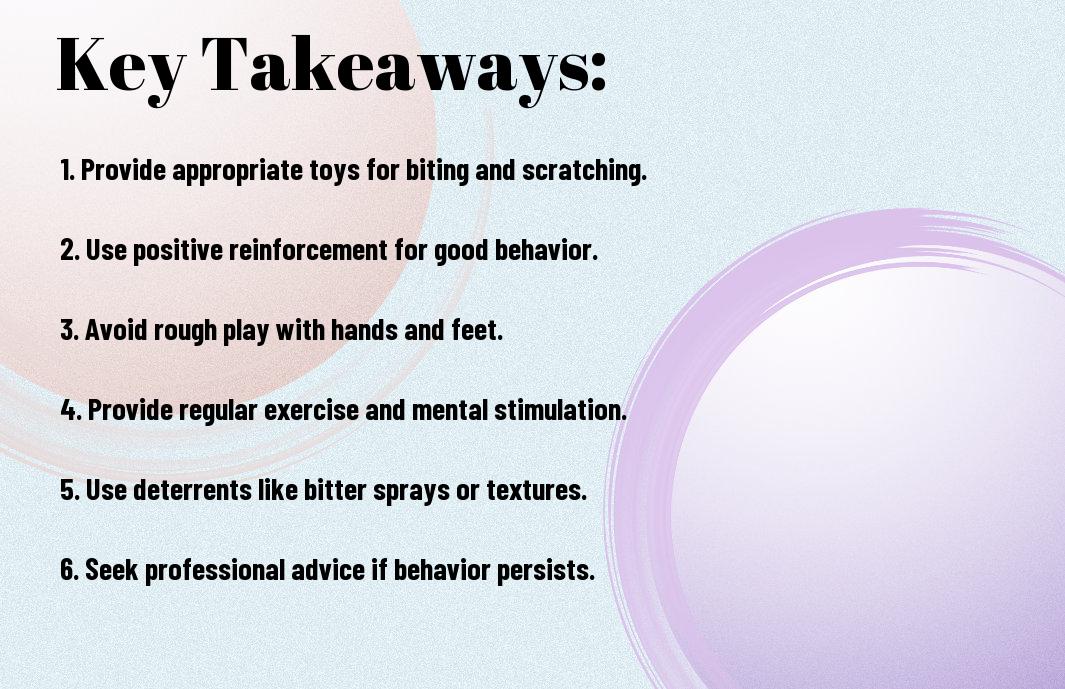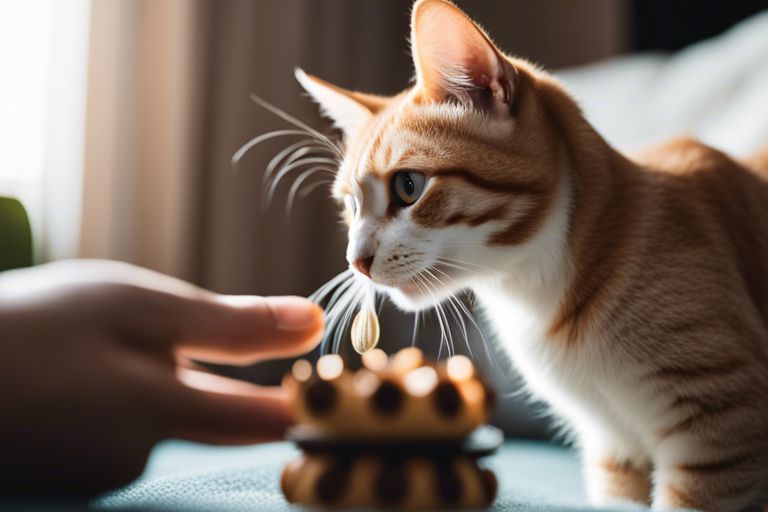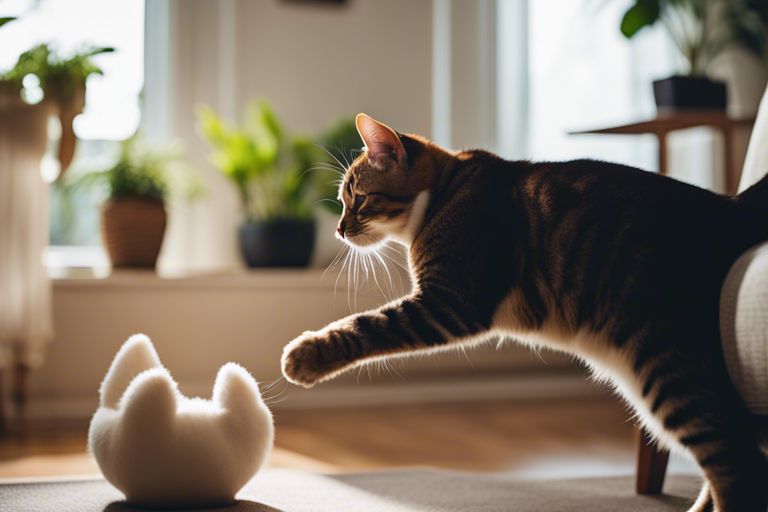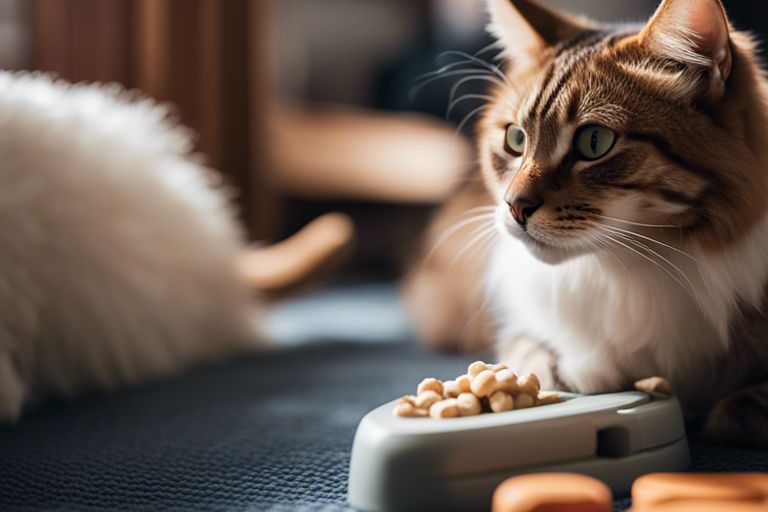Experiencing unwanted behavior from your feline companion can be frustrating and even dangerous. If your cat has a habit of biting and scratching, it’s important to address this behavior before it escalates. In this blog post, I will provide you with effective strategies to help curb your cat’s aggressive tendencies and create a more harmonious relationship between you and your furry friend. With the right approach, you can teach your cat to use gentle play and prevent painful encounters.
Key Takeaways:
- Understand the reason behind the behavior: Cats often bite and scratch due to various reasons such as fear, playfulness, or overstimulation. Understanding the root cause can help in implementing effective strategies.
- Provide appropriate outlets for their energy: Engage your cat in interactive play sessions with appropriate toys to channel their energy in a positive manner, which can reduce biting and scratching behavior.
- Use positive reinforcement: Reward good behavior with treats and affection to encourage positive habits and discourage biting and scratching.
- Provide scratching posts and pads: Give your cat designated areas to scratch to help minimize destruction of furniture and redirect their natural instinct to scratch.
- Seek professional help if needed: If the biting and scratching behavior persists or becomes aggressive, consult with a veterinarian or animal behaviorist for further assistance in addressing the issue.


Strategies for Minimizing Aggressive Behavior
Clearly, dealing with a cat’s aggressive behavior can be challenging. Whether it’s biting, scratching, or play aggression, it’s essential to address these behaviors early on to prevent them from becoming a habit. Here are some strategies to help you minimize your cat’s aggressive behavior.
Proper Play Techniques
When playing with your cat, it’s important to use appropriate play techniques to avoid encouraging aggressive behavior. Avoid using your hands as toys, as this can lead to your cat associating hand movements with play and inadvertently encourage biting and scratching. Instead, use interactive toys such as wand toys or laser pointers to engage your cat in play. Rotating toys regularly can also keep playtime interesting and prevent boredom-related aggression.
Training Methods to Discourage Biting and Scratching
One effective training method to discourage biting and scratching is to use positive reinforcement. Whenever your cat engages in gentle play or refrains from biting and scratching, reward them with treats, praise, or extra playtime. Conversely, if your cat becomes aggressive during play, immediately stop the interaction and walk away. This teaches your cat that aggressive behavior results in the end of play, helping them to associate gentle behavior with positive outcomes.
Additionally, providing appropriate outlets for your cat’s natural behaviors can also help minimize aggressive tendencies. Scratching posts, interactive toys, and regular physical and mental stimulation can help reduce pent-up energy and aggression.
Environmental Enrichment for Cats
To address your cat’s biting and scratching behavior, environmental enrichment plays a crucial role. By providing a stimulating environment for your cat, you can redirect their energy away from destructive behaviors and towards healthier outlets. If you want more in-depth information on this topic, check out Train your cat to stop scratching and biting.
Importance of Enrichment
Enrichment is essential for your cat’s overall well-being. When a cat doesn’t have enough mental and physical stimulation, they may turn to biting and scratching as a way to release pent-up energy or to alleviate boredom. Providing an enriched environment can help prevent these unwanted behaviors by keeping your cat engaged and satisfied.
Enrichment Ideas to Prevent Biting and Scratching
There are numerous enrichment ideas you can incorporate into your cat’s environment to discourage biting and scratching. Interactive toys and puzzles can keep your cat mentally engaged and provide an outlet for their hunting instincts. Scratching posts and pads are vital for allowing your cat to satisfy their urge to scratch in an appropriate manner. Vertical space, such as cat trees or shelves, can give your cat a place to climb and observe their surroundings, promoting mental stimulation and exercise. Rotating toys and hiding treats around your home can keep your cat entertained and mentally sharp. By enriching your cat’s environment, you can help prevent biting and scratching while promoting a happier, healthier feline companion.
Health-Related Considerations
Now, let’s discuss the health-related considerations when dealing with a biting and scratching cat. It’s essential to consider the potential health issues that may be causing your cat’s aggressive behavior.
Health Issues Related to Aggression
When your cat is exhibiting aggressive behavior such as biting and scratching, it could be a sign of underlying health issues. Issues such as dental problems, skin conditions, or chronic pain can lead to aggressive behavior in cats. Additionally, behavioral issues could also stem from the cat experiencing stress or anxiety. It’s important to take these factors into consideration when addressing your cat’s behavior and seek professional help if necessary.
When to Consult a Veterinarian
If you notice that your cat’s biting and scratching behavior is persistent and severe, it’s crucial to consult a veterinarian as soon as possible. Your vet can conduct a thorough examination to rule out any underlying health issues or pain that may be causing the aggression. They can also provide you with guidance on addressing your cat’s behavior and recommend appropriate treatment options. Remember, your cat’s health and well-being should always be a top priority, so don’t hesitate to seek professional help when needed.
Building a Positive Human-Cat Relationship
Despite the negative behavior of biting and scratching, it’s important to focus on building a positive relationship with your cat. This will help to create an environment where your cat feels safe and secure, and less likely to act out aggressively. By establishing a strong bond with your cat, you can reduce the instances of biting and scratching.
Establishing Trust with Your Cat
Building trust with your cat is essential for creating a positive human-cat relationship. Trust is earned, not demanded, so be patient and consistent in your efforts. Spend quality time with your cat, engage in regular play sessions, and provide a comfortable and stress-free environment at home. When your cat feels safe and secure, they are less likely to exhibit aggressive behaviors such as biting and scratching. Be respectful of your cat’s boundaries and give them the space they need.
Consistency and Patience in Training
Training your cat to stop biting and scratching requires consistency and patience. Set clear boundaries and be diligent in enforcing them. Use positive reinforcement such as treats and praise when your cat displays good behavior. Avoid punishment, as this can lead to fear and anxiety, which may exacerbate the problem. Remember, training takes time and patience, so be persistent and remain calm, even when faced with challenging behavior.

Strategies for Getting a Cat to Stop Biting and Scratching
Now that you are aware of some effective strategies for getting your cat to stop biting and scratching, it’s important to remember that consistency is key. By providing appropriate toys, redirecting their behavior, using positive reinforcement, and seeking veterinary advice if necessary, you can successfully train your cat to exhibit more desirable behaviors. Remember to be patient and persistent in your efforts, and with time and dedication, you will see positive results.
FAQ
Q: Why is my cat biting and scratching?
A: Cats may bite and scratch for a variety of reasons, including play, fear, frustration, or overstimulation. It’s important to understand your cat’s behavior and address the root cause of their biting and scratching.
Q: What are some strategies for getting my cat to stop biting and scratching?
A: One effective strategy is to redirect your cat’s attention to appropriate toys and activities. Additionally, using positive reinforcement and gentle discipline can help to teach your cat that biting and scratching are not acceptable behaviors. Providing plenty of mental and physical stimulation through play and environmental enrichment can also reduce unwanted behaviors.
Q: When should I seek professional help for my cat’s biting and scratching behavior?
A: If your cat’s biting and scratching behavior is causing injury or distress, it’s important to seek help from a veterinarian or a professional animal behaviorist. They can help identify any underlying medical or behavioral issues and provide appropriate guidance and treatment to address the problem. Don’t hesitate to seek professional help if you’re struggling to manage your cat’s behavior on your own.

Jayley, a devoted cat enthusiast, also writer for other cat blog as well. She aims to dedicated to providing comprehensive information, insights, and advice on everything you’d ever want to know about our whiskered companions.
